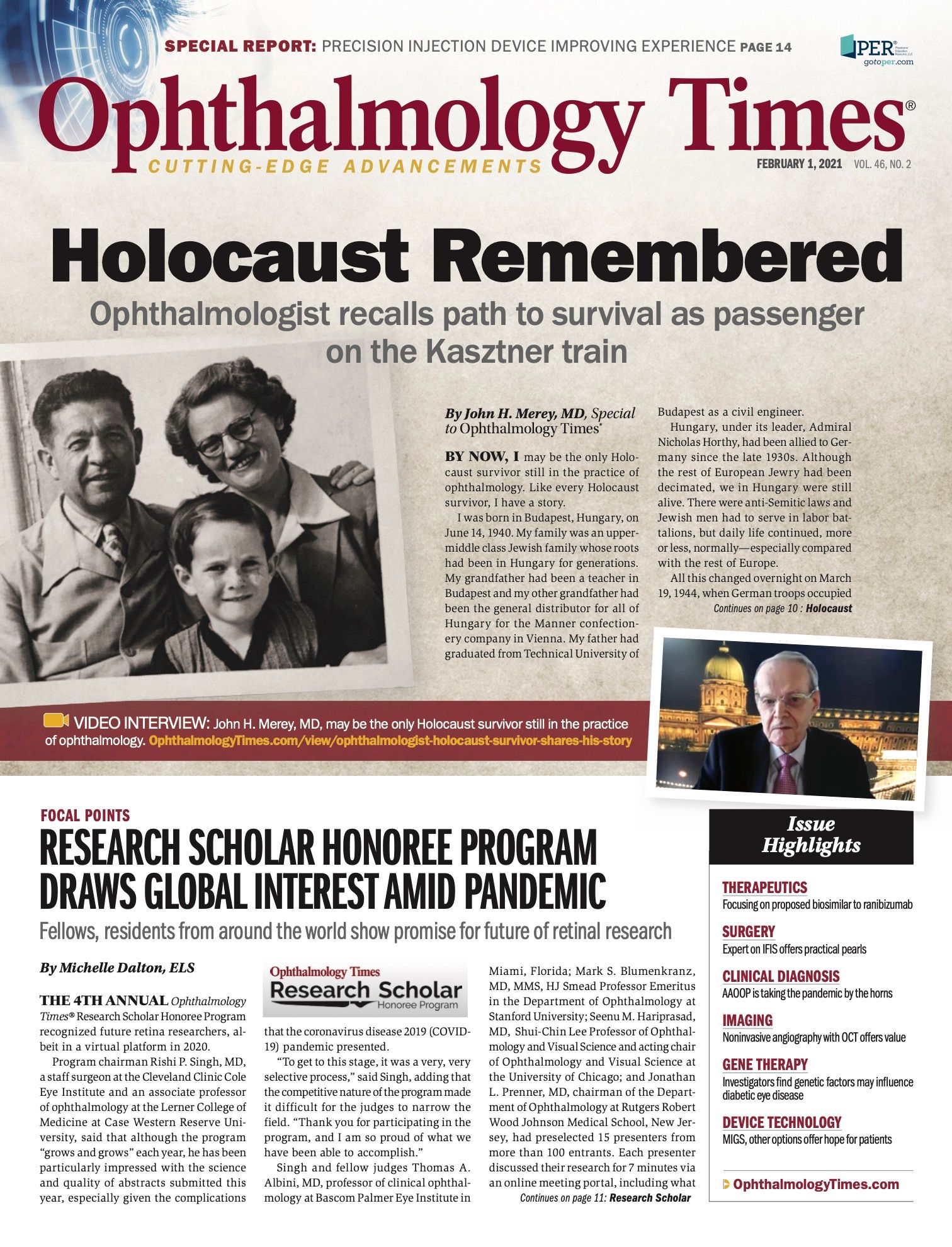Publication
Article
Digital Edition
Probe of IRIS Registry data reveals pandemic's impact on ophthalmology patient care
Author(s):
Visits, elective procedures decreased as physicians responded to COVID-19 guidelines.

Reviewed by Steven D. Schwartz, MD
Analyses of data collected in the American Academy of Ophthalmology (AAO) Intelligent Research in Sight (IRIS) Registry suggest that US ophthalmologists, and specifically retina subspecialists, responded appropriately to patient-care guidelines issued by AAO leadership at the start of the coronavirus disease 2019 (COVID-19) pandemic, said Steven D. Schwartz, MD.
“The investigation showed a decrease in patient visit volume following the release of the AAO statement on March 18, 2020, but also suggested that urgent and emergency patients were appropriately prioritized and well cared for,” said Schwartz, the Ahmanson Chair in Ophthalmology at the UCLA Stein Eye Institute in California.
“Data pertaining to anti-VEGF injections for patients with highly active disease suggest they received careful, individualized management without an adverse effect on their visual outcomes,” he said.
Real-world insights
Although individual ophthalmologists may vary in their experiences and perceptions of how the pandemic affected their patients and practices, the analyses of the IRIS Registry data sought to gain broader insight on these issues by analyzing real-world evidence, Schwartz explained.
“Ultimately we all strive to improve patient care in our practice of ophthalmology. We were interested in determining how ophthalmology responded to the pandemic and if the interruption it caused to in-person visits led to patient harm,” he said.
The analyses were conducted by Verana Health, the end-to-end data and technology partner for the AAO IRIS Registry.
Theodore Leng, MD, MS, an associate professor of ophthalmology at Byers Eye Institute at Stanford University School of Medicine in Palo Alto, California, led the analysis team for this research at Verana Health, where he is a consulting ophthalmologist.
Response to guidance on patient care
The AAO letter on March 18, 2020, which came from AAO CEO David W. Parke II, MD, stated it was essential that all ophthalmologists cease providing treatment other than urgent or emergency care.
Analyses of daily patient visits from January 2020 to June 27, 2020, showed a decrease in the prepandemic volume, which averaged 214,000 visits per day, immediately after March 18, 2020.
The decline continued, reaching a trough on April 10at approximately 34,000 visits per day, and then visits per day began to rebound as areas of the country started to open up.
“Clearly, the letter from AAO leadership was the seminal event modifying our behavior as a specialty,” Schwartz said.
Further analyses showed parallel patterns in the numbers of visits for new and returning patients.
Commenting on the similarity, Schwartz said that it showed both groups of patients had their issues prioritized above any perceived COVID-19 exposure risk.
Another analysis investigated changes in patient visits to retina practices versus to nonretina specialists and optometrists.
The results indicated that retina subspecialists continued to care for the urgent/emergency patients with vision-threatening conditions, accounting for an increased percentage of overall patient visits at the height of the visit slowdown in April.
Compared with January through March when visits to retina subspecialists accounted for approximately 20% of the total visits, subspecialists’ share of the total volume had nearly doubled in April, reaching 38.5%.
Additional analyses considered potential geographic variations in the visit trends and showed no differences among providers in urban, suburban, or rural locations.
However, a state-by-state analysis found that the largest decline in patient visit volume during the spring slowdown occurred in the Northeast region of the United States.
Furthermore, in contrast to the overall rebound in patient visits that began in late April, the decline in the Northeast persisted through late June.
An analysis focusing on the 5 states without “stay-at-home” orders (Arkansas, Iowa, North Dakota, Nebraska, and South Dakota) showed declines in patient visit volume that tracked with that of the overall nationwide behavior.
“It was appropriate to see the largest decline in patient visits in the Northeast, which was hit hardest by the pandemic during the spring,” Schwartz said. “The data for the states with no stay-at-home order suggest that as a field, ophthalmologists trusted our leadership and followed scientific recommendations, including rebounding with cautious care and putting patient safety at the fore.”
Anti-VEGF injection activity
Analyses of anti-VEGF injection data showed that in the 12 weeks leading up to March 18, 2020, approximately 1.5 million injections were recorded in the IRIS Registry, a weekly average of 122,785 injections.
During the 12 weeks after March 18, the total number of injections received decreased to approximately 1.2 million, averaging just below 100,000 per week.
Recognizing that patients receiving anti-VEGF injections represent a range of diagnostic severity across a broad range of treatment strategies and diagnoses, another analysis was undertaken that focused on the sickest patients.
“This approach included 39,819 eyes that had received one injection in the same eye monthly during the 5-month period before March 18 and was expected to be more instructive of how practices responded to the pandemic,” Schwartz said.
The results showed that nearly 50% of the group continued to receive monthly injections during April through June, and approximately 40% of the group received at least 1 injection during the 3-month study period.
Overall, vision was stable in all 3 subgroups, Schwartz reported.
Mean distance visual acuity was 20/50- in the prepandemic period and remained at 20/50- among patients who received monthly injections and in the subgroup that received at least 1 injection. It fell only by approximately 1 line in the group that went untreated.
--
Steven D. Schwartz, MD
E: sdschwartz@mednet.ucla.edu
Schwartz is on the board of directors of Verana Health and one of the founding directors.

Newsletter
Don’t miss out—get Ophthalmology Times updates on the latest clinical advancements and expert interviews, straight to your inbox.





